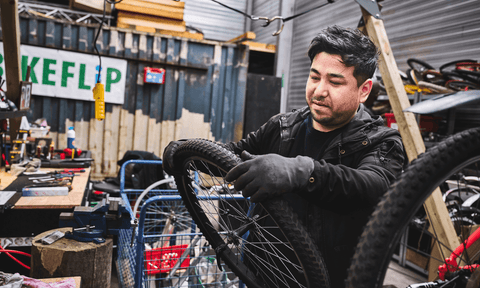A flat tire is perhaps the most common bicycle problem. Especially with children's bikes, which are often used a bit rougher. Fortunately, it is also a problem that you can easily solve yourself. Even if you have never replaced a tire. In this blog we explain how to repair a flat tire or fit a new inner tube.
What you need
Before you start, make sure you have these items ready:
- Tire levers (2 of 3)
- A bicycle pump (make sure it fits the valve)
- Adhesive kit (sandpaper, glue, stickers)
- Bucket of water or plant sprayer
- Open-end wrench (usually size 15)
- Possibly an Allen key for the chain guard or brakes
- A new inner tube (optional, if the old one is no longer good)
- Old cloth or towel
First of all: is the tire really flat?
A soft tire is not always a flat tire. Sometimes a bicycle tire slowly deflates when the bike is stationary for a long time, for example in the winter. First pump up the tire properly and see if it is still hard a few hours later. If not, then you do indeed have a flat tire and you can get started.
Loosening the wheel
Start with the wheel that has a flat tire. If the tire is in the front wheel, you're in luck: that's usually pretty simple. You turn the bike upside down (on the saddle and handlebars), unscrew the nuts on the wheel with the wrench and lift the wheel out. Sometimes you have to release the brakes, for example with V-brakes, by squeezing the brake arms towards each other so that the cable comes loose.
Is the leak in the rear wheel? Then it gets a bit more technical. Here too, you start with the bike upside down. If there are gears on the bike, shift to the smallest rear sprocket. Then you loosen the chain guard (if there is one) and loosen the nuts of the rear wheel.
Now push the wheel forward a little bit first — this will give the chain some slack and you can get it off the sprocket. If you don't do this, the chain will stay tight and you can pull as much as you want, but the wheel won't come off. Once the chain is loose, pull the wheel back and remove it.
Remove the inner tube and locate the leak
With the wheel out, you can loosen the outer tire. Use your tire levers to do this: stick one between the tire and the rim and lever the outer tire loose. Start opposite the valve and work your way around. Usually, you only need to loosen one side. Then you can pull the inner tube out.
To find the leak, inflate the inner tube a little. Hold it under water in a bucket or spray it with some water and dishwashing liquid. If bubbles appear somewhere, you have found the leak. Mark the spot with a pen or tape.
Paste or replace
Is it a small hole and does the inner tube look good otherwise? Then you can patch the puncture. Let the air out of the tire, roughen the area around the puncture with the sandpaper and apply a thin layer of glue. Let it dry until it is no longer shiny. Stick the patch on firmly, press it down and let it sit for a few minutes.
Does the tire look old and brittle, or do you have multiple leaks? Then it is better to replace the entire inner tube. Pay close attention to the size: it is stated on the side of the outer tire, for example 20 x 1.75. Buy a tire in exactly the same size.
Putting the tire back on
Put the inner tube back into the outer tyre. Start at the valve and work your way around. Make sure the inner tube is not folded or pinched between the rim. Then press the outer tyre back onto the rim. Sometimes you can do this by hand, otherwise you can use the tyre levers – carefully, so that you don't puncture the inner tube again right away.
Pump up
Pump the tire back up until it feels firm. The side of the tire says how much pressure to put in it, but with a child's bike it doesn't have to be that precise. In any case, make sure it doesn't feel spongy.
Putting the wheel back on
With the front wheel this is easy: place it between the fork, tighten the nuts, re-attach the brake if you had loosened it – done.
The rear wheel is a bit more complicated. You have to put the chain back on the rear sprocket. Then pull the wheel back a bit to tension the chain.
What exactly does it mean to tension the chain? Grab the middle of the chain – somewhere between the pedals and the rear wheel – and push it up and down a bit. It should be able to move about 1 to 2 centimeters. Not too tight (then it will wear out quickly), not too loose (then it can fall off).
Once the wheel is positioned correctly and the chain moves up and down a little, tighten the nuts securely.
Finished!
You've fixed it. It may be a bit of a hassle the first time, but you'll learn a lot from it and it'll go a lot faster the next time. And your child can get back on the road safely. Do you never want to have to fix a bike again? Who knows, our sustainable children's bike subscription might be something for you. For a fixed monthly fee, a children's bike that always fits, with unlimited free repairs. Then you'll never have to get your hands dirty again.




